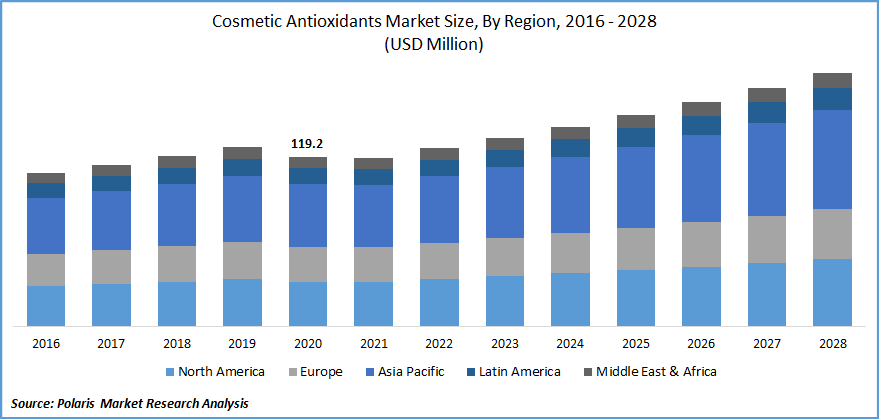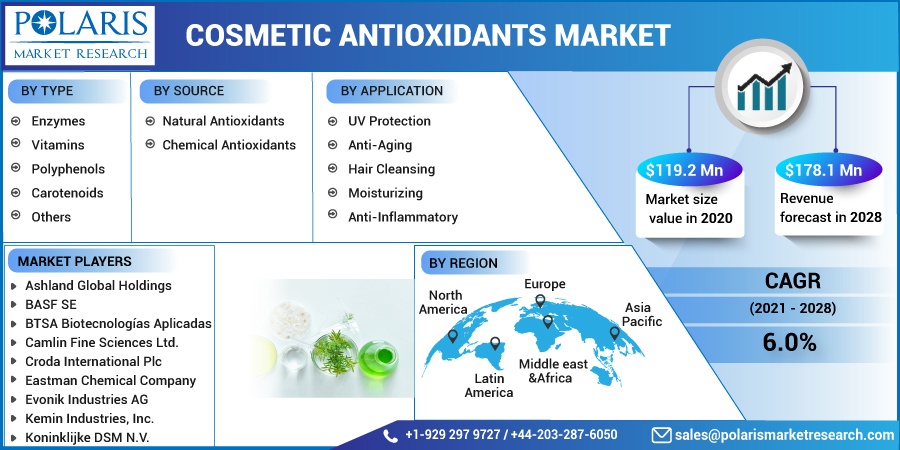
Cosmetic Antioxidants Market Share, Size, Trends, Industry Analysis Report
By Type (Enzymes, Vitamins, Polyphenols, Carotenoids, Others); By Source; By Application; By Region; Segment Forecast, 2021 - 2028
- Published Date:Oct-2021
- Pages: 111
- Format: PDF
- Report ID: PM1644
- Base Year: 2020
- Historical Data: 2016 - 2019
Report Outlook
The global cosmetic antioxidants market size was valued at USD 119.2 million in 2020 and is expected to grow at a CAGR of 6.0% during the forecast period. Cosmetic antioxidants are being used for the development of skin, anti-aging, and hair care products with superior properties.
 Know more about this report: request for sample pages
Know more about this report: request for sample pages
Antioxidants, which are made of enzymes, vitamins, carotenoids, and polyphenols, offer protection against dry skin, anti-aging, cellular damage, and acne. Growing occurrences of skin disorders due to air pollutants, increasing awareness regarding antioxidants, and rise in urbanization have increased the demand for anti-wrinkle creams, sunscreen lotions, and moisturizers.
Market players have integrated voice assistant applications, augmented reality, and virtual tours for branding and improved customer engagement. However, the COVID-19 outbreak has disrupted the supply chain across the world.
Many countries have regulated movement of individuals and goods, resulting in decreased deliveries, roadblocks, and other logistic issues. The market for cosmetic antioxidants is expected to grow post COVID-19 and attract investments and research initiatives to increase applications of cosmetic antioxidants.
 Know more about this report: request for sample pages
Know more about this report: request for sample pages
Industry Dynamics
Growth Drivers
The global cosmetics antioxidants market is driven by growth in aging population, increasing disposable income, and changing living standards. There has been rising awareness regarding personal care and skin care among consumers, which is being leveraged by market players to develop products aimed towards male consumers. Growing demand from the entertainment industry, rising consciousness among the youth, and increasing adoption of western culture are some factors boosting the market growth for cosmetic antioxidants.
Consumers are turning towards natural and organic skincare products due to harmful long-term effects associated with certain chemicals. The global market is also fuelled by the economic growth in developing countries such as China, Japan, and India, technological advancements, and significant rise in investments for research and development.
E-commerce platforms have gained popularity for sale of cosmetics, especially during the pandemic. Convenience offered by online platforms coupled with wide variety of choices available are key factors behind the success of online portals in the cosmetics market. Lifestyle changes of consumers, growing awareness regarding skincare, and increasing inclination towards the use of natural ingredients support the growth of cosmetic antioxidants.
The online distribution channel is well established in developed markets such as North America and Europe due to higher internet penetration and greater adoption of mobile devices. However, significant growth in sale of cosmetics through online channels has also been registered in the developing economies, encouraging many new market entrants to launch their own e-commerce sites.
The demand for personal care products has increased during the pandemic, whereas hair care, sunscreen, and makeup products have experienced a decline in their demand. Market players are introducing natural and organic ingredients to cater to consumer demands. Sale of cosmetics through online platforms has gained traction owing to lockdowns and closure of stores across the globe.
Report Segmentation
The market is primarily segmented on the basis of type, source, application, and region.
|
By Type |
By Source |
By Application |
By Region |
|
|
|
|
Know more about this report: request for sample pages
Insights by Type
On the basis of type, the market is segmented into enzymes, vitamins, polyphenols, carotenoids, and others. The vitamins segment dominated the global market in 2020. Vitamins offer skin protection against sun damage and skin cancer. They accelerate the skin's natural repair systems and inhibit further damage.
Vitamins in cosmetics protect and correct the damage by neutralizing free radicals initiated by ultraviolet light and environmental pollutants. Some vitamins also offer benefits such as anti-inflammatory effects, suppression of pigmentation and bruising, and stimulation of collagen production.
Insights by Source
On the basis of source, the market is segmented into natural antioxidants and chemical antioxidants. The demand for natural antioxidants is expected to increase during the forecast period. Plants produce natural antioxidant compounds responsible for controlling oxidative stress caused by sunlight and oxygen.
The major factors driving the growth of this segment for cosmetic antioxidants include growing adoption of natural and organic products, increasing awareness regarding harmful effects of chemical-based products, and research & development.
Insights by Application
The application segment has been divided into UV protection, anti-aging, hair cleansing, moisturizing, anti-inflammatory, and others. The demand for anti-aging cosmetics has increased owing to greater consciousness regarding healthy and youthful appearance.
Cosmetic antioxidants are incorporated in anti-aging products for preventing and minimizing signs of skin aging. The major factors driving the growth of this segment include growing awareness regarding health and wellness, increasing trends of beauty, rising awareness regarding benefits of cosmetic antioxidants.
Geographic Overview
Asia Pacific dominated the global cosmetic antioxidants market in 2020. Increasing awareness regarding health, supportive government regulations, and growing geriatric population are some factors attributed to the growth in this region.
Leading industry players in the region, increasing disposable income, and changing lifestyles have increased the demand for cosmetic antioxidants. Increasing awareness regarding personal care and skincare and rising occurrences of skin-related disorders further support the industry growth in the region.
Competitive Landscape
The leading players in the cosmetic antioxidants market include Ashland Global Holdings, BASF SE, BTSA Biotecnologías Aplicadas, Camlin Fine Sciences Ltd., Croda International Plc, Eastman Chemical Company, Evonik Industries AG, Kemin Industries, Inc., Koninklijke DSM N.V., Lonza Group, Nutreco N.V., Wacker Chemie AG, Barentz International BV, Merck Group, Jan Dekker International BV, Yasho Industries, Provital, Nexira
These players are expanding their presence across various geographies and entering new markets in developing regions to expand their customer base and strengthen their presence in the industry. The companies are also introducing new innovative products in the industry to cater to the growing consumer demands.
Cosmetic Antioxidants Market Report Scope
|
Report Attributes |
Details |
|
Market size value in 2020 |
USD 119.2 million |
|
Revenue forecast in 2028 |
USD 178.1 million |
|
CAGR |
6.0% from 2021 - 2028 |
|
Base year |
2020 |
|
Historical data |
2016 - 2019 |
|
Forecast period |
2021 - 2028 |
|
Quantitative units |
Revenue in USD million and CAGR from 2021 to 2028 |
|
Segments covered |
By Type, By Source, By Application, By Region |
|
Regional scope |
North America, Europe, Asia Pacific, Latin America, Middle East & Africa |
|
Key Companies |
Ashland Global Holdings, BASF SE, BTSA Biotecnologías Aplicadas, Camlin Fine Sciences Ltd., Croda International Plc, Eastman Chemical Company, Evonik Industries AG, Kemin Industries, Inc., Koninklijke DSM N.V., Lonza Group, Nutreco N.V., Wacker Chemie AG, Barentz International BV, Merck Group, Jan Dekker International BV, Yasho Industries, Provital, Nexira. |
